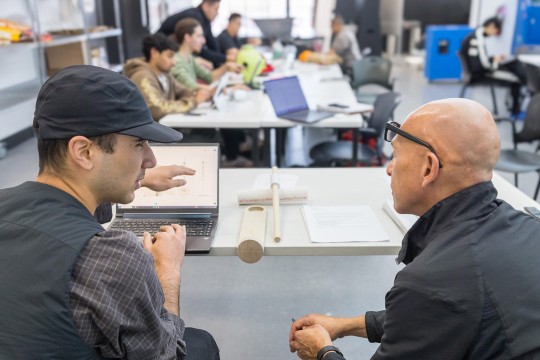RIT part of national event on 3D-printed devices
More than 500 people attend event devoted to e-NABLE, a community created by an RIT researcher
Scott Bureau
Jon Schull, a research scientist at RIT and founder of e-NABLE, explains the function of the ‘RIT Arm,’ an inexpensive 3D-printed prosthetic arm designed and created by students at RIT.
About 25 children with upper limb differences will be able to go to school this week with new 3D-printed prosthetic hands, as a result of the Prosthetists Meet 3D Printers conference held Sept. 28 at John Hopkins Hospital in Baltimore. RIT was among several co-sponsors of the daylong conference, which highlighted the work of e-NABLE, founded by RIT Research Scientist Jon Schull.
Schull and seven Rochester Institute of Technology students joined more than 500 people at the event to help teach parents and their child with upper limb differences how to build their own 3D-printed prosthetic hands. The group also learned about the future of 3D-printed prostheses and showcased work at RIT in creating 3D-printed prosthetic arms.
E-NABLE is an online volunteer community that is leading the way by developing inexpensive 3D-printed prostheses for children and adults in need.
“This first-of-its-kind event for 3D-printed prostheses was an astounding success,” said Jon Schull, who is a research scientist at RIT’s Center of Media, Arts, Games, Innovation and Creativity (MAGIC). “In addition to learning new things that we can use to improve prostheses, we also got to bring together an online community that has never had the chance to meet in person.”
Schull created e-NABLE in 2013 to bring together 3D-printing hobbyists and professionals with people in need of prostheses. While a custom prosthetic devices can cost more than $10,000, a mechanical 3D-printed hand can be made using free designs available online and about $50 worth of materials. Schull currently works along with RIT students to improve prosthetic designs and donate hands to local residents in need.
“I learned all about new methods that you can use to improve the quality of a 3D-print, including how cooling effects the way plastic shoots out of the nozzle,” said Emily Sanseverino, a third-year biomedical engineering student from Candia, N.H., who is completing cooperative education experience with Schull and the RIT team. “I’m excited to bring the things we’ve learned back to the RIT lab so we can improve our prosthetic arm design.”
In addition to presentations by medical and industry leaders and innovators, policy analysts discussed the vital role that 3D printing can play in delivering affordable healthcare.
By the end of the day, the e-NABLE group had built more than 100 hands. Many will be donated to children in need across the country and in Haiti.
“I think that someday there will be a point where we won’t be able to tell difference between 3D-printed prosthetic devices and traditional devices,” said Dr. Albert Chi, a trauma surgeon at conference host Johns Hopkins Hospital, and a world-renowned researcher on state-of-the-art prostheses. “The future is bright and the future is now.”
Other sponsors for the conference included Johns Hopkins University, manufacturers of open-source 3D printers Ultimaker, the prosthetics firm Dankmeyer Inc., the Mercatus Center of George Mason University and the University of Wisconsin-Milwaukee.













